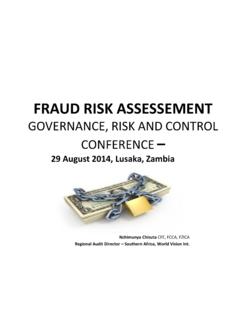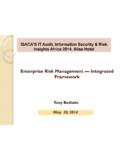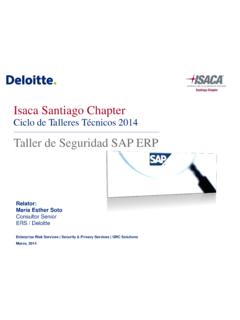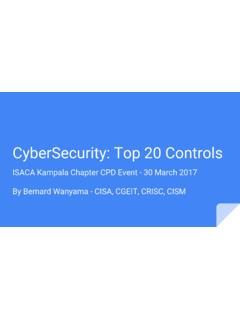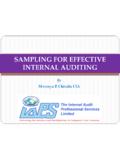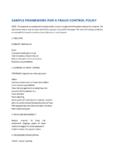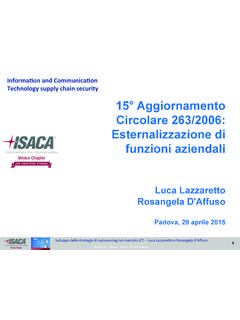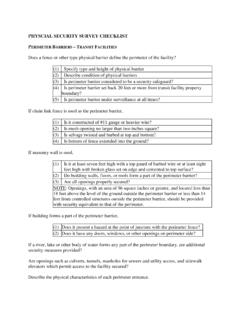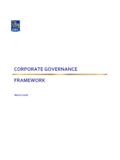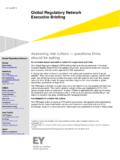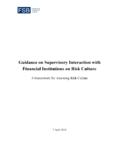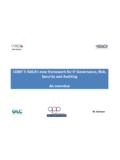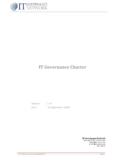Transcription of Risk IT A set of guiding principles and the first ...
1 Risk ITA set of guiding principles and the first framework to help enterprises identify,govern and effectively manage IT risk. In business today, risk plays a critical role. Almost everybusiness decision requires executives and managers tobalance risk and reward. Effectively managing thebusiness risks is essential to an enterprise s success. Too often, IT risk (business risk related to the use of IT) is business risks , such as market risks , credit risk and operationalrisks have long been incorporated into the corporate decision-makingprocesses. IT risk has been relegated to technical specialists outside theboardroom, despite falling under the same umbrella risk category asother business risks : failure to achieve strategic objectives. The problem is clear. The solution? now:Introducing Risk ITRisk IT is a framework based on a set of guiding principles for effective management of IT risk.
2 The framework complements COBIT , a comprehensive framework for thegovernance and control of business-driven, IT-based solutions and services. While COBIT provides a set of controls to mitigate IT risk, Risk IT provides a framework for enterprises to identify, govern and manage IT risk. Simply put, COBIT provides the means of riskmanagement; Risk IT provides the ends. Enterprises who have adopted (or areplanning to adopt) COBIT as their IT governance framework can use Risk IT to enhance risk management. The Risk IT principles The Risk IT framework is about IT risk business risk related to the use of IT. The connection to business is founded in the principles on which the frameworkis built. Effective enterprise governance and management of IT risk: Always connects to business objectives Aligns the management of IT-related business risk with overall enterprise risk management (ERM) if applicable, , if ERM is implemented in the enterprise Balances the costs and benefits of managing IT risk Promotes fair and open communication of IT risk Establishes the right tone from the top while defining and enforcing personal accountability for operating within acceptable and well-defined tolerance levels Is a continuous process and part of daily activities Managing and Understanding IT RiskTo prioritize and manage IT risk, senior executives need a frame of reference and a clear understanding of the IT function and IT risk.
3 However, the enterprise s key stakeholders, including board members and executive management, the very people whoshould be accountable for risk management within the enterprise, often do not have a full risk is not just a technical issue. While IT subject matter experts help to understand andmanage aspects of IT risk, business management is the most important managers determine what IT needs to do to support their business; they set thetargets for IT and are accountable for managing the associated risks . The Risk IT framework explains IT risk, allows the enterprise to make appropriate risk-awaredecisions and will enable users to: Integrate the management of IT risk into the overall enterprise risk management (ERM) of the organization Make well-informed decisions about the extent of the risk, the risk appetite and the risk tolerance of the enterprise Understand how to respond to the risk In summary, the framework will enable enterprises to understand and manage all significantIT risk types.
4 The Risk IT framework provides an end-to-end, comprehensive view of all risksrelated to the use of IT, as well as a similar view of risk management. The framework fills thegap between generic risk management frameworks like COSO ERM and AS/NZS 4360 (soonto be replaced by ISO31000) and its British equivalent, ARMS6, and detailed (primarilysecurity-related) IT risk management frameworks. Risk IT PublicationsRisk IT consists of two publications: the Risk IT Frameworkand the Risk IT Practitioner Guide. TheRisk IT Frameworkprovides: A set of governance practices for risk management. An end-to-end process framework for successful IT risk management. A generic list of common, potentially adverse, IT-related risk scenarios that could impact the realization of business objectives. Tools and techniques to understand concrete risks to business operations, as opposed to generic checklists of controls or compliance the building blocks the framework provides, a comprehensive process model for IT riskis built.
5 For users of COBIT and Val IT, this will look familiar. Guidance is provided on the keyactivities within each process, responsibilities for the process, information flows betweenprocesses and performance management of each process. The model is divided into three domains Risk Governance, Risk Evaluation, Risk Response each containingthree processes: Risk Governance Establish and Maintain a Common Risk ViewIntegrate with Enterprise Risk Management (ERM)Make Risk-aware Business Decisions Risk Evaluation Collect DataAnalyze RiskMaintain Risk Profile Risk Response Articulate RiskManage RiskReact to EventsThe Risk IT Practitioner Guideis a support document for the Risk IT framework thatprovides examples of possible techniques to address IT-related risk issues more detailedguidance on how to approach the concepts covered in the process model. Concepts and techniques explored in more detail include: Building scenarios, based on a set of generic IT risk scenarios Building a risk map, using techniques to describe the impact and frequency of scenarios Building impact criteria with business relevance Defining KRIs Using COBIT and Val IT to mitigate risk; the link between risk and COBIT and Val IT control objectives and key management practices Your Solution to IT RiskApplying good IT risk management practices as described in Risk IT will provide tangiblebusiness benefits, , fewer operational surprises and failures, increased informationquality, greater stakeholder confidence and reduced regulatory concerns, innovativeapplications supporting new business initiatives.
6 The Risk IT framework is part of ISACA sproduct portfolio on IT governance. Although this document provides a complete andstandalone framework, it does include references to COBIT and Val the PractitionerGuide, issued in support of this framework, makes extensive reference to COBIT and Val IT, it is recommended that managers and practitioners acquaint themselves with the majorprinciples and contents of these two frameworks. Like COBIT and Val IT, Risk IT is not astandard, but a flexible framework. This means that enterprises can and should customizethe components provided in the framework to suit their particular is Risk IT?Risk IT is: A framework to help establish effective governance and management of IT risk Part of ISACA s product portfolio on IT governance A framework based on a set of guiding principles for effective management of IT riskWhat does Risk IT do?Risk IT: Allows enterprises to customize the components provided in the framework to suit their particular needs Provides an end-to-end, comprehensive view of all risks related to the use of IT and a similarly thorough treatment of risk management, from the tone and culture at the top, to operational issues Enables enterprises to understand and manage all significant IT risk types Provides tangible business benefits Allows the enterprise to make appropriate risk-aware decisions Explains how to capitalize on an investment made in an IT internal control system already in place to manage IT-related risk Enables integration with overall risk and compliance structures within the enterprise when assessing and managing IT riskWhat are the benefits of using Risk IT?
7 The benefits of using Risk IT include: A common language to help communication amongst business, IT, risk and audit management End-to-end guidance on how to manage IT-related risks A complete risk profile to better understand risk, so as to better utilize enterprise resources A better understanding of the roles and responsibilities with regard to IT risk management Alignment with ERM A better view of IT-related risk and its financial implications Fewer operational surprises and failures Increased information quality Greater stakeholder confidence and reduced regulatory concerns Innovative applications supporting new business initiatives3701 Algonquin Road, Suite 1010 Rolling Meadows, IL 60008 USAWeb site: : + : +.
